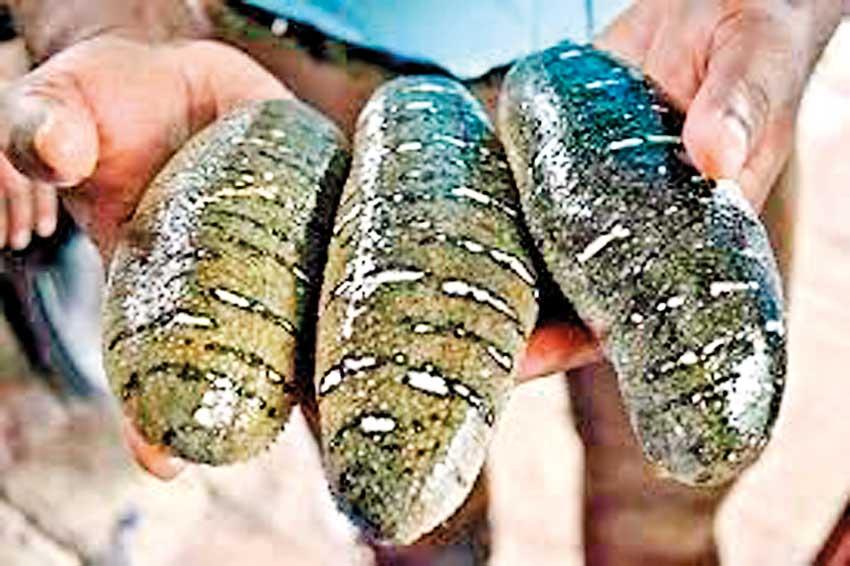20 Oct 2022 - {{hitsCtrl.values.hits}}

Sea cucumber farming in Sri Lanka is quite old and was introduced by the Chinese. Sea cucumber was reported to be one of the major commodities taken to China for centuries when the trade existed via the ancient silk route
 Barrel-shaped Holothuroidea, commonly known as sea cucumbers are part of a larger animal group called echinoderms, which also contains starfish and sea urchins. All sea cucumbers are ocean dwellers, though some inhabit the shallows and others live in the deep ocean. There are more than 1,000 known species of sea cucumbers that inhabit the world’s oceans, but only about two dozen are commercially important.
Barrel-shaped Holothuroidea, commonly known as sea cucumbers are part of a larger animal group called echinoderms, which also contains starfish and sea urchins. All sea cucumbers are ocean dwellers, though some inhabit the shallows and others live in the deep ocean. There are more than 1,000 known species of sea cucumbers that inhabit the world’s oceans, but only about two dozen are commercially important.
Sea cucumbers are amongst the highest-value seafood available commercially. Sea cucumber has a long history of utilisation as a cuisine in the Southeast Asian region, primarily due to their nutritional value and they are considered a delicacy. In some countries, medicines are produced, for example, “gamat oil” in Malaysia. The most important sea cucumber product is the dried body wall which is marketed as beche-de-mer (trepang or haisom).
Sea cucumbers are amongst the highest-value seafood available commercially. Sea cucumber has a long history of utilisation as a cuisine in the Southeast Asian region, primarily due to their nutritional value and they are considered a delicacy
Sea cucumber farming in Sri Lanka is quite old and was introduced by the Chinese. Sea cucumber was reported to be one of the major commodities taken to China for centuries when the trade existed via the ancient silk route. But the demand has arisen sharply with a high price tag, so farming surged in the 1980s in coastal areas.
Sri Lankan sea cucumbers are exported to countries like Singapore, China, Hong Kong, and Taiwan where they are highly prized and the delicacy sells for hundreds of dollars per kilo, bringing the much-needed foreign exchange to Sri Lanka. In 2020, Sri Lanka exported about 326 tonnes of sea cucumbers worth Rs 1.5 billion and has become an important source of income for fishermen in the north, east, and north-western coastal region.
Since there is a growing demand for sea cucumber in the export market, the Sri Lankan government has taken steps to promote sea cucumber farming among the local fishing communities to support their livelihood and bring much-needed foreign exchange
to the country.
Sea cucumber farming in Sri Lanka is quite old and was introduced by the Chinese. Sea cucumber was reported to be one of the major commodities taken to China for centuries when the trade existed via the ancient silk route
Sri Lanka has got favourable environmental conditions to develop a large-scale sea cucumber industry, however, given the limitations on sustainable production from wild sea cucumber capture, access to a regular supply of wild juvenile sea cucumbers for culture, and limited technical skills and knowledge among intended aquaculture practitioners hindered the long-term sustainable development of sea cucumber industry in Sri Lanka.
At the time, when many northern fishermen were finding it harder to catch large fish which is blamed on many Indian trawlers entering Sri Lankan waters without a license and using illegal fishing methods like poaching and mechanised bottom trawling. It deprives the livelihoods of Sri Lanka fishermen, national fish production, the export income of fishing, and the rich ecosystem of the Sri Lankan waters and poses a threat to national security. The use of mechanised bottom trawling methods by the Indian fishermen is also a serious threat to the fishing gear of the fishing communities of the coastal areas.
Even sea cucumbers are illegally harvested by Indian bottom trawlers in Sri Lankan water. The secretary of Mannar District Fishermen Federation Union, N.M. Aalam told a local newspaper that “The Indians are arbitrarily engaged in the harvest of sea cucumbers in our waters in addition to ongoing disastrous bottom trawling activities, they sell us back the same thing with some value addition.”
In 2001, India banned the harvest of all varieties of sea cucumber and declared it a protected species under the Indian Wildlife (Protection) Act of 1972, whereas in Sri Lanka it is legal and harvesting can be done under a licensing system.
To address these needs, with the support of the Sri Lankan government, the Chinese joint venture company, Gui Lan (Pvt) Ltd, established an artificial breeding production facility (hatchery) in Jaffna’s coastal village of Ariyalai in April 2016, to provide the necessary juvenile cucumbers stock to support a thriving and sustainable industry which can uphold local community’s livelihood hit hard by illegal Indian fishing. Gui Lan (Pvt) Ltd’s operation involves the hatchery and the nursery to meet the locals’ demands and is not engaged in farming.
Gui Lan (Pvt) Ltd was a pioneer in mass-producing juvenile sea cucumbers in Sri Lanka using their own eco-friendly, artificial spawning technique. Since starting production, Gui Lan (Pvt) Ltd nursed baby animals for up to four months before they were sold to commercial farms run by locals throughout the entire year.
Earlier farmers used to have sea cucumbers only for six months of the year, now fishermen have them year-round. This has helped many northern farmers grow their businesses without harming the natural sea cucumber population. After a Chinese firm started a sea cucumber farm in the Northern Province, over 600 fishermen switched to sea cucumber farming.
Without a doubt, the local community massively benefitted from the company, by its technological expertise which helped them to obtain bigger harvests and earn more income from exports at higher prices. The Sri Lankan government also earned “a significant amount” of foreign exchange by exporting sea cucumbers to China and other Southeast Asian nations.
The National Aquaculture Development Authority (NAQDA) research shows that farming is the easiest, most lucrative, and more importantly, sustainable way of supporting an industry because wild sea cucumbers have been over-exploited. Hatchery-based artificial breeding is the most environmentally sustainable technique for raising sea cucumbers. Earlier, the Fisheries Ministry had taken steps to ban the overexploitation of wild sea cucumber cultivation from the sea directly to avoid depletion of wild populations in Sri Lankan waters.
In June this year, the Sri Lankan Government informed that they approved a proposal to allocate 5,000 acres of land in the districts of Jaffna, Kilinochchi, Mannar, and Batticaloa for large-scale commercial sea cucumber hatcheries. Further, the government approved the release of 100 acres to set up export villages as well.
Speaking to a local newspaper on September 28, 2022, Minister of Fisheries Douglas Devananda said that sea cucumber farms established by Chinese industries will not bring any harm to fishermen in the Northern Province and some of these industries have been operating in the North for the past four to five years. Further, he said that these investments are much needed for the country.
The Minister told an Indian newspaper, “We need both investment and technology in the north to cultivate sea cucumbers. I have been asking India for five to six years but have not had any response. We must explore other options, right? We are only talking to a Chinese firm; no project has been finalised yet,” adding he will “never allow” any threat to India’s security concerns.
So how can a Chinese company’s investment in a Sea Cucumber farm in Northern Sri Lanka become a threat to India? Why can’t India stop Indian trawlers from entering Sri Lankan waters without a license and using illegal fishing methods, crushing the Northern fishing community’s livelihood? Why then can’t India invest in the Sea Cucumber industry and provide technological expertise as the Chinese companies and support their livelihood and bring much-needed foreign exchange
to the country?
Earlier, Sri Lanka suspended a Hybrid Energy system to be built in three northern islands of Sri Lanka by a Chinese high-tech renewable energy company after India lodged a strong protest with Sri Lanka on the award of a tender to a Chinese company owing to security concerns. Now it is embarrassing to see that Sri Lanka needs to buy fuel from the Lanka Indian Oil Corporation (LIOC) to run thermal electricity generators which also imports fuel by opening letters of credit (LCs) at Sri Lankan banks and using the dollars available in Sri Lanka, which is not helpful to Sri Lanka.
In September, the Sri Lankan government invited the LIOC to set up Sri Lanka’s second oil refinery in Trincomalee, but until now no positive response was given by LIOC. But India will come with another security concern when China agrees to invest and set up an oil refinery in Trincomalee which can provide guaranteed energy security and supply stability to Sri Lanka in the future and make Sri Lanka a petroleum hub in the Bay of Bengal.
India also raised concerns about the Chinese research and survey vessel Yuan Wang 5 docking at Hambantota International Port, however, Sri Lanka allowed entry for Yuan Wang 5 despite India’s concerns.
The writer currently serves as a Director of BRISL, an independent & pioneering Sri Lankan-led organization, with strong expertise in BRI advice and support. He can be contacted at:
[email protected]
26 Dec 2024 8 minute ago
26 Dec 2024 2 hours ago
26 Dec 2024 3 hours ago
26 Dec 2024 3 hours ago
26 Dec 2024 3 hours ago